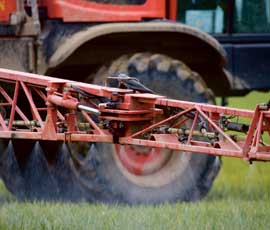Benefits from stem-based foliar fungicides

Using stem-based foliar fungicides this spring could significantly improve second wheat yields, says Clare Bend, technical manager for Masstock.
Second wheat crops can suffer from extra pressure from eyespot and fusarium stem-base browning so the T0 and T1 fungicide timings are particularly important, she says.
“Consider using a strobilurin such as fluoxastrobin or azoxystrobin at T0. These work through soils, so it’s important to get them on early when there is less canopy to intercept the spray.” Spraying before a light rain also helps wash the chemical into the soil, she adds.
The new SDHI chemistry can also be a sensible option at T1, rather than just the T2 timing which most manufacturers are recommending for first wheat crops, says Mrs Bend. “People might think they should spend less on fungicide inputs in second wheat crops as the yield potential is lower than a first wheat, but our trials show a clear benefit.”
Recent trials carried out by the firm for its Best of British Wheat Campaign suggest using SDHI chemistry at T1 can help improve the number of ears per square metre by maximising tiller retension and increase green leaf area at the plant base. Applying an SDHI at T1 as well as T2, therefore, will help improve yield potential.
“Increased green leaf area on lower leaves is particularly important for second wheat crops as they are generally thinner and will let more light through the canopy.”
Bixafen product Boogie from Bayer offered the greatest improvement in green leaf area with 8% more than the next-best SDHI-treated plots.
Nutrition is also crucial for second wheat crops and growers should prioritise second wheats for early nitrogen applications. “Aim to achieve a higher Green Area Index than a first wheat. About 40% of the total nitrogen requirement should have been applied in February.”
Manganese plays a key role in take-all development, so growers should use T0, T1 and T2 fungicide timings to ensure the crop has an adequate supply says Mrs Bend. “Even where you think you have got enough manganese in the soil, the take-all fungus can speed oxidisation to the insoluble form, making it unavailable to the plant.”
Copper is also important for reducing the effects of take-all and can also be added with early fungicide treatments, she adds.
• Masstock agronomists will be on hand at this year’s Cereals event to answer any questions relating to wheat management through it’s Best of British Wheat campaign.

